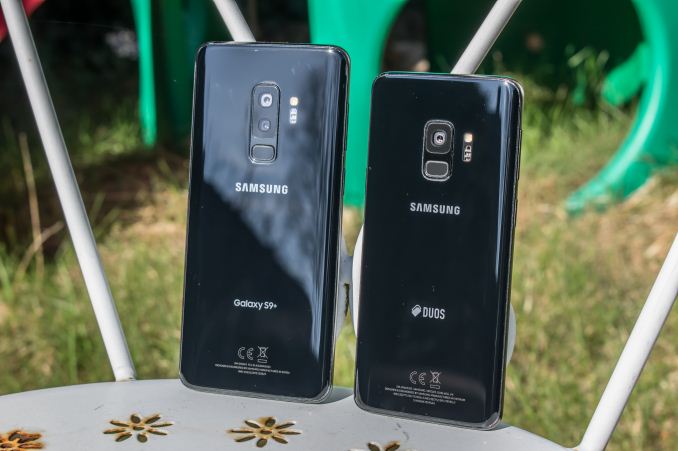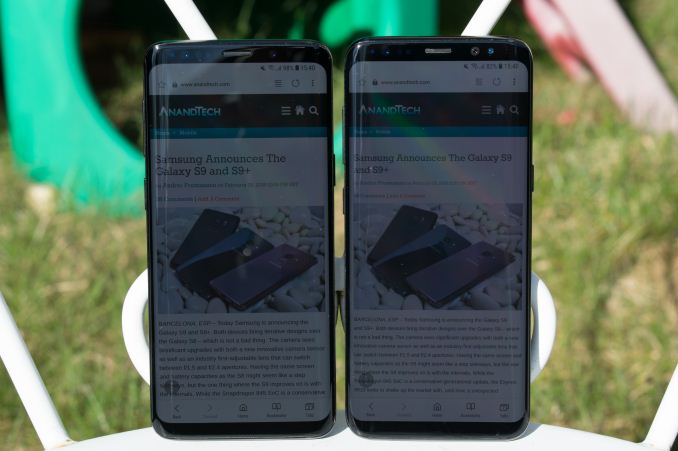The Samsung Galaxy S9 and S9+ Review: Exynos and Snapdragon at 960fps
by Andrei Frumusanu on March 26, 2018 10:00 AM ESTConclusion & End Remarks
The conclusion for the Galaxy S9 is always the toughest part to write as it’s where we have to reconcile all the pros and cons of the device and making a verdict on its value as a product to customers.
In terms of design, the S9 iterates on the S8 and I think that’s definitely a positive until Samsung somehow produces a better design overhaul. The changes we find here aren’t exactly ground-breaking and most people will get used to them very fast. The fingerprint scanner location is among the biggest ergonomics changes and while for me personally it didn’t do much, there’s plenty of people who find it an improvement.
The speaker sound quality of the Galaxy S9 is a massive improvement and this is now by far the best sounding smartphone device. The stereo speakers as well as the audio processing tuning along with the improved main speaker design all just provide a much better experience. I may not have covered this in the introduction, but Samsung’s choice to retain the 3.5mm jack is absolutely the right thing to do. I’ve got very strong feelings about companies’ rationales behind removing the headphone jack and find their reasoning either misguided or outright misleading, and just very anti-consumer choice. Here’s to hoping that Samsung sticks with it in the future, and as absurd as this is that I have to praise them for it, I have to do it to ensure that companies listen.
The screen of the Galaxy S9 holds very little surprises as it has only marginal improvements over the S8. It’s still among one of the best screens on smartphones, and honestly there’s not much more to say.
The camera of the Galaxy S9 for me had some high points and some low points. The high points are that the variable aperture of the S9 has real benefits and direct advantages in picture quality in day-light shots. The S9’s reduced usage of sharpening provided the cleanest pictures among all smartphones and thanks to its improved sensor its effective spatial resolution is actually higher than some higher resolution camera devices. The low-light shots also come with a quality improvement over the S8 – although it will depend on the lightning and scene to notice them at their full effect. Right now the S9 has the best low-light camera.
While the hardware of the S9’s camera definitely deserves praise, the software has notable issues in daylight shots. The Galaxy S9 has a very bad tendency to overexpose and compress the image’s dynamic range. In Pro mode these issues largely go away, but for the Galaxy S9 to offer a better point-and-shoot experience than the S8 or the new iPhones, Samsung needs to rework its camera calibration in Auto mode as right now it can be the odd one out in terms of results.
Finally, the biggest story for the Galaxy S9 is its big contrast in terms of SoC hardware. Ever since we first heard about the Exynos 9810 we had very large expectations and we knew there would be some tangible differences between Exynos and Snapdragon variants. The expectations couldn’t be more shattered than the results we got. While the Snapdragon 845 variant of the Galaxy S9 performed largely as advertised and as we had been told to expect by Qualcomm, the Exynos 9810 failed to live up to its hype in real-world scenarios. Effectively, the Exynos 9810 variant and as evidenced by all the data we collected, is the slower variant of the two. The root cause here has been identified as the extremely conservative scheduler and DVFS mechanisms which essentially nullify any advantage the new M3 cores have in synthetic benchmarks.
In 3D benchmarks, the Exynos 9810 posted very healthy efficiency improvements and even sometimes managed to catch up to last year’s Adreno 540 – something I hadn’t expected. Qualcomm’s new Adreno 630 raises the bar in terms of peak performance, however the promises of increased efficiency have not materialised in the commercial hardware as the performance boost comes at a cost of increased power. Effectively, when looking at sustained workloads, the Snapdragon 845 isn’t any faster than the Snapdragon 835 in its GPU department. Fortunately for Qualcomm, they’re still in the lead and this is not a deal-breaker for the Galaxy S9.
While the performance advantage of the Snapdragon 845 variant over the Exynos 9810 variant is something we could live with, the battery life results of the Exynos is definitely a deal-breaker. I’m not sure of the root cause here and whether it’s something that can be fixed by software, but showcasing such a battery runtime regression over its predecessor is universally something that we can all agree on as not acceptable for a flagship device. Based on our testing, it’s especially in heavy use-cases where this will most evident. The Snapdragon 845 variant performed as expected in the battery life tests.
Finally the recommendation of the Galaxy S9 will be based on which market you are in and which variant you’ll be able to purchase. The Snapdragon 845 variant in the US, China and Japan is a healthy upgrade over its predecessors and I don’t really have much to say against it as a phone, besides the camera exposure issues. Here Samsung iterated and perfected over the S8, and whether the S9 is worth to you as an upgrade is something you’ll need to decide based on its individual parts, because as a package, the Snapdragon S9s don’t disappoint.
For readers in markets with the Exynos variant I need to take a slightly different tone. Make no mistake as I say that the Exynos S9 is by far not a bad phone. If you come from older generation devices you will see significant upgrades, but as a flagship coming at a price premium we expect a no-compromise device, and here is where the Exynos S9 doesn’t tick all boxes. The battery life regression that we measured is the single most concerning aspect of the device. Here buyers will need to consider the device with caution and well-thought out consideration and should maybe apply a wait & see approach over the coming months – for one to see if Samsung resolves the issues via software, and secondly, to await the release of competitor’s new product lines for possible better alternatives.












190 Comments
View All Comments
madnav - Tuesday, April 3, 2018 - link
This review is not really meant to serve as a comparison between other android phones. This review (or rather analysis) is to show how each SOC OEM has progressed over years; and how the actual implementation in products turn out.Some of us appreciate this level of technological attention to underlying details; irrespective of whether the information affects end user or not.
For "avg day-to-day usage" i think no one really needs to spend on devices above $200 today. A person spending top money will want to know that the product was built with top quality and latest technology feasible; and that is exactly what analysis like this brings to its readers.
Kehboz 2943 - Tuesday, March 27, 2018 - link
I Just upgraded from a Droid turbo 2 to a Google pixel 2 XL I compared it to the S9+ when I asked the salesman what he used he said he liked the pixel 2 XL over the S9+ and he said the pixel 2 XL was cheeper in price my carrier is Verizon I've never owned a Samsung anything so I just took the salesmans word for it I can't tell if I made the right choice. If anyone has compared the two or would like to comment I welcome the feedbacklilmoe - Tuesday, March 27, 2018 - link
It's been a while since we got a PRO review. Thank you very much Andrei, best stuff as usual.Anyway, yes, best phone with best features. I'll recommend the device to family and friends, but I won't touch it myself. I knew this won't be changing in production units, but I'm totally disappointed in the default scheduler settings. Samsung is losing a LOT of PR with how much they're holding back this monster version of Exynos. No, feature and performance parity with Snapdragon is NOT acceptable. I thought they'd stop being too damn conservative with ramping up clocks. This is totally unacceptable from an enthusiast perspective. I also thought they'd be upgrading the UFS Nand storage, not the case, also disappointing.
Sigh.... Oh well. Until when, Samsung???
tuxRoller - Tuesday, March 27, 2018 - link
Perf parity? If they were aiming for that they did a piss poor job.madnav - Tuesday, March 27, 2018 - link
@Andrei FrumusanuCan this article be updated with the details of the FW that S9 and S9+ were running? (FW and date/month of FW)
It will help readers track how long it actually takes Samsung to fix the scheduler.
julandorid - Tuesday, March 27, 2018 - link
What is the reason for comparing the smaller model S9 Exynos with the bigger brother S9 Plus Snapdragon?In my opinion there are too many differences for this years models that can cause 5-10% difference or even more just because of the different performance plans, scheduler, thermals and thus the whole performance behavior, not to mention the extra 2GB that also could affect the overall performance between S9 and S9+ and thus Exynos in S9 and SD in S9+.
phoenix_rizzen - Tuesday, March 27, 2018 - link
Because that's what they were given by Samsung or able to source locally? It's mentioned right in the article that they tried to get the same SoC version in each size but were unable to.ctchb - Tuesday, March 27, 2018 - link
Can you compare the camera image quality and speed of snapdragon vs exynos? Their ISPs are different, and this is a big factor of camera performance.nedooo - Tuesday, March 27, 2018 - link
Amazing review, more like scientific analysis.I am surprised to see Snapdragon 845 bases its power advantages over 835 is "smoke and mirrors" short unsustainable bursts. But maybe "always on" laptops will fully utilize its power...
warrenk81 - Tuesday, March 27, 2018 - link
Great to see AT going back at flagship devices. Could you compile all those benchmarky bits of the 2017 devices into a recap or something? Apple and Google both shipped big new things in 2017 that guys just ignored.